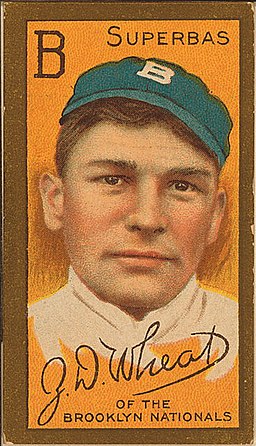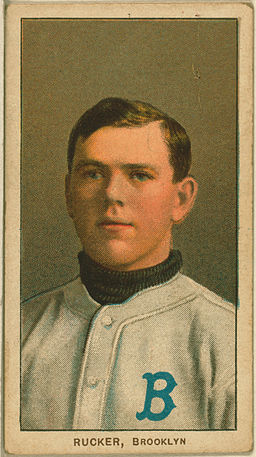I tried to be clever with the title of the Angels all-time team post, but I’m not even going to attempt that here.
How would that go? The All-Time Brooklyn/Los Angeles Atlantics/Grays/Grooms/Bridegrooms/Superbas/Robins/Dodgers Team?
Anyway, I want to make the point that this, and every other post in this series, is an all-time team considering the entire history of the franchise. In this case, that dates all the way back to the 1884 Brooklyn Atlantics.
Franchise History
Los Angeles Dodgers (1958- )
Brooklyn Dodgers (1911, 1912, 1932-1957)
Brooklyn Robins (1914-1931)
Brooklyn Superbas (1899-1910, 1913)
Brooklyn Bridegrooms (1888-1890, 1896-1898)
Brooklyn Grooms (1891-1895)
Brooklyn Grays (1885 – 1887)
Brooklyn Atlantics (1884)
The Dodgers weren’t one of the original National League franchises. In fact, their history starts in the American Association, where they played as the Atlantics, Grays and Bridegrooms from 1884 to 1889. They joined the NL in 1890 and promptly won the championship in their first year.
Actually, the team’s franchise timeline on their web site considers 1890 to be origination of the franchise’s history, but I’m not going to get into that controversy. For my purposes, it turns out to be a moot point, although the infamous Bob Caruthers did play for the team in their pre-NL days.
When selecting these teams I emphasize the advanced metrics since it’s difficult to compare players across eras otherwise. But, I do like to consider where guys rank in franchise history in terms of some of the traditional counting stats, so I’ve included those as well.
WAR Statistics referenced for each player are from Baseball-Reference.com. All other statistics used here are gathered from that site as well.
An asterisk (*) denotes a Hall of Famer.
Starters
C – Roy Campanella* (1948-1957)
4815 PA, 31.6 WAR, 123 OPS+, 242 HR (4th), 856 RBI (8th)
1B – Gil Hodges (1943, 1947-1961)
7935 PA (6th), 40.1 WAR (7th), 120 OPS+, 1088 R (5th), 1884 H (9th), 361 HR (2nd), 1254 RBI (2nd)
2B – Jackie Robinson* (1947-1956)
5804 PA, 58.7 WAR (3rd), 132 OPS+, 947 R (7th)
SS – Pee Wee Reese* (1940-1942, 1946-1958)
9470 PA (2nd), 63.1 WAR (1st), 99 OPS+, 1338 R (1st), 2170 H (1st), 885 RBI (7th), 232 SB (10th)
3B – Ron Cey (1971-1982)
6108 PA, 45.4 WAR (6th), 125 OPS+, 228 HR (5th), 842 RBI (10th)
LF – Zack Wheat* (1909-1926)
9721 PA (1st), 56.5 WAR (4th), 130 OPS+, 1255 R (2nd), 2804 H (1st), 1210 RBI (3rd)
CF – Willie Davis (1960-1973)
8035 PA (4th), 51.2 WAR (5th), 107 OPS+, 1004 R (6th), 2091 H (3rd), 849 RBI (9th), 335 SB (3rd)
RF – Duke Snider* (1947-1962)
7633 PA (7th), 62.8 WAR (2nd), 142 OPS+ (9th), 1199 R (3rd), 1955 H (4th), 389 HR (1st), 1271 RBI (1st)
Now, that’s a pretty amazing lineup, isn’t it? Five Hall of Famers, and three others whose names are known to come up to varying degrees in such debates. I haven’t done this before in this series, but just for the heck of it, I’ll throw my idea for a batting order into the potential discussion:
Robinson 2B
Reese SS
Wheat LF
Snider RF
Campanella C
Cey 3B
Hodges 1B
Davis CF

Zack Wheat
Image via Wikimedia Commons
So, what were the toughest decisions here?
- Adam‘s latest wWAR formula gives Mike Piazza’s Dodgers days a slight edge over Campanella at catcher, but I feel pretty confident going with Campy for the first-team.
- I’m sure an argument could be made for Steve Garvey over Hodges at 1B. When I was witnessing Garvey’s career as a youngster, I’ve got to admit he felt like a Hall of Famer to me. With hindsight, and the benefit of advanced statistical analysis, I don’t feel that way anymore. But, to be honest, I still have trouble wrapping my head around evaluating the careers of players who were perennial all-stars during my formative years, but quite possibly were over-rated.
- I’m curious what the reaction will be to the fact I’ve moved Snider to RF for Davis. Let me get one thing straight first, though. If I had to choose between the two, I’d obviously choose Snider. But, since I rate Davis as the third best outfielder in Dodgers history, and it seems pretty clear he was a better defender than the Duke, I think the move makes sense.
Rotation
Dazzy Vance* (1922-1932, 1935)
2759 IP (4th), 59.8 WAR (1st), 129 ERA+ (5th), 190-131 W-L (3rd in Wins), 1918 SO (4th)
Sandy Koufax* (1955-1966)
2324 IP (10th), 50.3 WAR (3rd), 131 ERA+ (4th), 165-87 W-L (5th in Wins, 6th in W-L%), 2396 SO (3rd)
Don Drysdale* (1956-1969)
3432 IP (2nd), 57.4 WAR (2nd), 121 ERA+, 209-166 W-L (2nd in Wins), 2486 SO (2nd)
Nap Rucker (1907-1916)
2375 IP (8th), 45.5 WAR (5th), 118 ERA+, 134-134 W-L, 1217 SO (10th)
Don Sutton* (1966-1980, 1988)
3816 IP (1st), 46.6 WAR (4th), 110 ERA+, 233-181 W-L (1st in Wins), 2696 SO (1st)
That’s quite the rotation as well, including four Hall of Famers and one guy maybe some of you have never heard of, but who should be more celebrated than he is.

Nap Rucker
[Image via Wikimedia Commons]
The thing is, though, there’s a strange aspect to this all-time teams thing. Basically, we’re pretending each player is a composite (I’m sure there’s a better word than that, but it’s not coming to me right now) of the different versions of him throughout his career. In other words, Koufax is not just the pitcher who had one of the greatest peaks in history from 1961-1966 (1633 IP, 129-47, 156 ERA+, 44.4 WAR). He’s also the pitcher who struggled early in his career (1955-1960, 692 IP, 36-40, 100 ERA+, 5.9 WAR). Combining those two versions of Koufax brings him back down to earth a bit.
Now, if we’re having the proverbial “who would you want on the mound in one game for all the marbles?” discussion, I’d definitely choose Koufax, as long as we’re talking about the 1961-1966 version. Otherwise, you could definitely make a case for Vance, despite the fact he was a very late bloomer who didn’t win his first major league game until he was 31. But, all of those pre-30s struggles were before he came to Brooklyn, so they’re ignored for the purposes of this exercise.
Closer
Ron Perranoski (1961-1967, 1972)
767 IP, 14.0 WAR, 132 ERA+ (3rd), 101 SV (5th)
Reserves
C – Mike Piazza (1992-1998)
3017 PA, 30.7 WAR, 160 OPS+ (1st), 177 HR (8th)
1B – Steve Garvey (1969-1982)
7027 PA (8th), 34.1 WAR (9th), 122 OPS+, 1968 H (5th), 211 HR (6th), 992 RBI (5th)
2B/3B/OF – Jim Gilliam (1953-1966)
8322 PA (3rd), 37.7 WAR (8th), 93 OPS+, 1163 R (4th), 1889 H (8th)
SS/3B – Maury Wills (1959-1966, 1969-1972)
6745 PA, 29.7 WAR, 87 OPS+, 876 R (10th), 1732 H (10th), 490 SB (1st)
OF/3B/1B – Pedro Guerrero (1978-1988)
4089 PA, 30.8 WAR, 149 OPS+ (5th), 171 HR (9th)
OF – Carl Furillo (1946-1960)
7022 PA (9th), 31.8 WAR, 112 OPS+, 895 R (8th), 1910 H (7th), 192 HR (7th), 1058 RBI (4th)
Bullpen
Orel Hershiser (1983-1994, 2000)
2181 IP, 37.4 WAR (6th), 116 ERA+, 135-107 W-L (10th in Wins), 1456 SO (6th)
Jeff Pfeffer (1913-1921)
1748 IP, 31.4 WAR (7th), 125 ERA+ (10th), 113-80 W-L
Bob Welch (1978-1987)
1821 IP, 30.6 WAR (8th), 114 ERA+, 115-86 W-L, 1292 SO (9th)
Fernando Valenzuela (1980-1990)
2349 IP (9th), 30.4 WAR (9th), 107 ERA+, 141-116 W-L (9th in Wins), 1759 SO (5th)
Burleigh Grimes* (1918-1926)
2426 IP (5th), 26.8 WAR, 105 ERA+, 158-121 W-L (6th in Wins)
When I began this series over at my little corner of the internet, I asked for input from fellow bloggers on whatever team(s) they wished to offer contributions. Our very own Bryan O’Connor sent me his all-time Dodgers team, but I left a few of his suggestions off this squad. I think I can summarize our differences of opinion by saying Bryan places more emphasis on peak value and pure greatness, while I’m trying to determine what players contributed the most to the history of the franchise in question (see comment re: Sandy Koufax above).
Here are the players Bryan advocated for that didn’t make my final cut:
Don Newcombe – Despite a 116 ERA+ and his status as the inaugural winner of the Cy Young award (in 1956), I felt Newk’s overall career fell a little short.
Eric Gagne – Assessing the all-time greatness of relievers is tough. I just thought Perranoski was better (14.0 WAR, 6.2 WAA, 132 ERA+ in 766 2/3 IP) than Gagne (10.4 WAR, 4.9 WAA, 125 ERA+ in 545 1/3 IP) and Jim Brewer (15.1 WAR, 6.5 WAA, 127 ERA+ in 822 IP), and didn’t think any other true relievers were worthy of the final bullpen spots.
Matt Kemp – It was pretty early in the 2012 season that Bryan sent me his picks, and Kemp didn’t really pad his resume this year (mainly due to injuries), so maybe he would take this one back. Kemp may very well get there someday, but I’m not ready to bump Guerrero or Furillo off for him. Among current players, I honestly came closer to taking Clayton Kershaw.
Johnny Podres – Podres’ inclusion would have been a defensible pick (as would all of these guys), but it was simply a numbers game. That is, there were just too many good pitchers to choose from.
Kevin Brown – See below.
Manager
Walter Alston (1954-1976)
2040-1613 W-L, 7 NL pennants, 4 World Series titles
I don’t have a magic formula I use to compare managers, so I suppose we could just as easily go with Tommy Lasorda here, but Alston won almost 500 more games and he led the team to four World Series victories to Lasorda’s two.
Greatest Eligible Non-Hall of Famer
Although for the purposes of the all-time Dodgers team, I considered only each player’s performance in a Dodgers (or Robins or Superbas) uniform, when it comes to deciding the franchise’s greatest eligible non-Hall of Famer, my criteria are slightly different. Obviously, I want to consider each player’s entire career, so the approach I take is to choose the best career among players who would likely enter the Hall of Fame with a Dodgers cap depicted on their plaque.
There are so many candidates for this distinction: Gil Hodges (40.7 career b-r WAR), who peaked at 63.4% on the BBWAA ballot, then was passed over by this past year’s Veteran’s Committee; the under-rated (but better appreciated by modern metrics) Ron Cey (50.4) and Willie Davis (56.8); Deadball era standout Nap Rucker (45.5); the sometimes under-appreciated Orel Hershiser (48.0); and Steve Garvey (34.4) and Maury Wills (37.5), who, along with Hodges, are the only other players here to remain on the writer’s ballot for the maximum 15 years.
So, I thought it would be interesting if we put it to a vote. Who do you consider the greatest Hall of Fame eligible player who would identify as a Dodger and is not (yet) enshrined?
I’m also going to throw two more names into the mix: Tommy John (56.9) and Kevin Brown (64.5), guys who didn’t make this team because they only played six and five years respectively for the Dodgers and there were just so many other good choices. For both of these players, it’s not certain what cap would be depicted on a potential Hall of Fame plaque, so I’ll let you make that decision before deciding whether or not to vote for them.
John played eight years with the Yankees and seven years with the White Sox, and rates higher by WAR for his time with both teams, but it wouldn’t be a huge surprise if he considered the Dodgers the team that most defined his career. Brown played eight years in Texas, but his best years were definitely with the Dodgers and Marlins, although he was only a member of the latter for two seasons.
